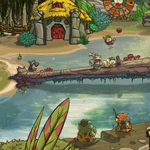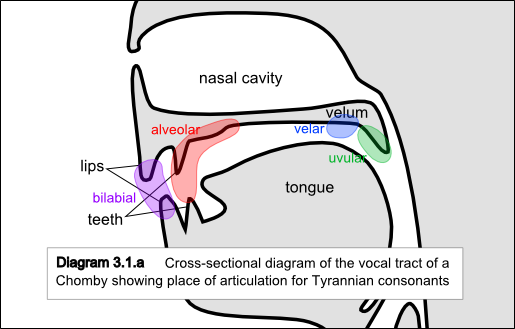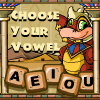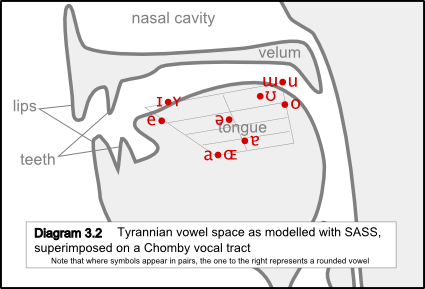 The Sounds of Tyrannian
by reiqua
--------
Hi! My name's Maya! I'm a grad student at Brightvale University. I'm studying Tyrannian linguistics under the supervision of Professor Agatha. Some time ago, I wrote an article for the Neopian Times entitled “How to say Ugga”. A lot of people contacted me afterwards, saying how fascinating it was. And professor Agatha tells me that enrolments for TYRL_104 have sky-rocketed this semester. I'm sure it's unrelated, but the Prof seems pretty happy anyway. She's encouraged me to write another article that provides a bit more in-depth information about the sounds of Tyrannian. So here goes! Every spoken language uses a set of sounds. But the set of sounds are actually different for each language! Tyrannian is no exception. When you're speaking Tyrannian, you have to use a different set of sounds to what you would when speaking English. This article should give you a thorough grounding in the sounds you use to speak Tyrannian, in four simple lessons. So if you're ready, let's begin!  First Things First: how do you make a sound? (Don't look at me like I'm stupid – this is actually important!) All the sounds in Tyrannian are what we call pulmonic sounds. That means you make the sounds by pushing air from your lungs (pulmonic) through your mouth. Now, all sounds are made by moving air. But it would be hypothetically possible to make a sound with the moving air coming from somewhere other than your lungs. Try clicking your tongue. You just made a sound without using your lungs! Now try saying 'ahh'. That's a pulmonic sound. The air from your lungs is passing through your mouth. And it's getting shaped into an 'ahh' sound by the position of your tongue. There! I bet that was something you'd never thought about before – the difference between pulmonic and non-pulmonic sounds. Maybe next time I teach you an important but simple lesson, you won't be so quick to scoff at me!  Okay, moving along to Lesson Number Two: vowels and consonants. (Hey, I thought we'd agreed you wouldn't roll your eyes at me like that anymore!) Vowels and consonants are the two main categories of sounds. I know you're thinking you know all about vowels and consonants. Vowels are 'a', 'e', 'i', 'o' and 'u'. And consonants are everything else. Well done, Captain Obvious. Those are indeed the vowels and consonants of spelling. You've correctly identified the vowel and consonant letters. And if you've finished being a smart alec, we can move on. What we're talking about here is actually vowel and consonant sounds. Remember what we learned earlier about how to make sounds? Using air from your lungs? Well the air from your lungs is like a constant force. It doesn't really change depending on what sound you're making. What changes the sound is how you shape that air, using your mouth. And vowel and consonant sounds are shaped differently. To shape a vowel sound, you use your tongue. Overall, the space in your mouth is still fairly open to make a vowel sound. But your tongue does shape the sound somewhat. Enough that we can hear the difference between 'eee' and 'ahh' for example. To shape a consonant sound, you use a much tighter constriction. You might shut of the airflow entirely, like with a 't'. Then, what you hear is the release of that constriction exploding in a 't' sound. Alternately, you might bring the airflow down to a tiny little passageway. Like with a 's' sound. That way, what you hear is the turbulence of the air rushing past your tight constriction. But however you make the consonant sound, you're constricting the air as it comes out of your lungs much more than you would for a vowel sound.  Okay, let's move on to Lesson Three: How to make consonants You might notice that I've picked an image of a transparent paint brush to head up this section. The introduction of transparent as a colour for Neopets in Y12 led to huge advances in understanding the way we produce sounds. Every year, more and more transparent painted 'pets are participating in research projects, allowing us to get a better understanding of how the tongue shapes our sounds. What we've learned is that there are different places we can produce sounds. But at each place, there are a number of different ways we can produce a sound. Take 't' and 's' for example. They're produced at exactly the same place as each other, but in different ways. Below I've included a pair of diagrams showing a side-view of a Chomby's mouth. The highlighted areas show the different places that you can produce sounds in Tyrannian (on the left) and English (on the right). Note that although these diagrams are specifically of a Chomby's mouth, they would look pretty much the same in any species, except that it would be slightly differently proportioned.   (Please ignore the wordy, academic captions – I just copied and pasted these out of an old academic journal article that Professor Agatha wrote) Now, looking at those pictures, you might be wondering why the highlighted patches are so big at times. Like that red patch on the left, for example. What we've found when it comes to speech sounds, is that “close enough is good enough”. You don't have to produce a sound in exactly the right place for people to hear it as you intended. So long as it's close to the sound you intended – and closer to that sound than it is to any other sound – then people will hear it as you intended. For example, take a look at the orange, red and pink areas in the picture on the right. In English, those three different places make three different sounds. Try making a 'th' sound – your tongue will be in the orange highlighted section, between your teeth. Now make a 's' – your tongue will migrate to the red area, just behind your teeth. And last of all, try a 'sh' – your tongue will be in the pink space for that one, up towards the roof of your mouth. To us, they're three different sounds. But to Tyrannian speakers, they're all the one sound. Close enough, good enough. The reason for this will be very obvious if you have a look around at some Tyrannian locals. You'll notice that large tusks feature very prominently in Tyrannian fashions. The end result of this is that the area that houses the teeth, highlighted in red in the left hand diagram above, will vary a lot from one species to the next. Having such a large degree of variation would make it nearly impossible to distinguish between a sound that is made at the teeth, versus one that is made just behind the teeth – it would change so much for each species! So in Tyrannian, they don't bother trying to make that distinction. They just have a group of sounds made with the tip of the tongue, somewhere in that general vicinity. Doesn't matter if it's between, behind or above the teeth – just somewhere nearby. Close enough is good enough! To make up for the fact that they have fewer 'front' consonant sounds, speakers of Tyrannian are much more precise about the production of their 'back' consonant sounds. To us, a sound made in the blue or green area might sound just like a 'k' (remember, close enough is good enough) But to Tyrannians, they're two completely different places, with two completely different sounds. As different as 's' and 'sh' are to us. Fascinating, huh? Lesson Three and a Half: Ways of producing consonant sounds. (I didn't warn you that lesson three was actually two lessons rolled into one, did I? Ha!) So we've talked about the different places you can produce consonant sounds. Like that red patch behind the teeth, for example. But what about the different ways of producing a sound in each of those places. We've already spoken about two. You could stop the airflow then release it (like a 't'), or you could make a close constriction and then blow past it (like a 's'), but there are other ways as well. One way is to completely block off the airflow through your mouth and send it through your nose instead. Try saying an 'm' sound. That's exactly what you're doing! You're not letting any airflow through your mouth, but instead it goes through your nose. You can also do that with an 'n' sound. Now that makes three main types of sounds we've spoken about so far. Stop sounds (t), blowy sounds (s) and nose sounds (n). There's one more type of sound, but it's a bit trickier, because it's not one we really use in English. It's called a trill. Try saying a rolled 'r'. You feel your tongue trilling, right? Well that's another way of making a sound in Tyrannian. Tyrannian uses trills in two different places – the red zone (that's a rolled 'r') and the green zone (that's like nothing you've ever heard before, but let's call it a rolled 'g'). Now another important consideration in how you say a sound is that some sounds can either be voiced or voiceless. (This only works for 'stop sounds' and 'blowy sounds'. Nose sounds and trill sounds are always voiced.) Think about the difference between a 's' and a 'z' for example. Exactly the same place – the red area. Exactly the same way of making the sound – you blow past your tongue. And yet they sound different. That's because you turn your voice off to say 's' but on for 'z'. Touch two fingers to your voicebox. Now try and say 'zzz'. You should be able to feel your voicebox buzz. Then swap it for a 'sss'. Notice the difference? The same voiced/voiceless change also applies to stop sounds. Using the red zone again for consistency, try saying a 't'. Now try a 'd'. Once again, you have the same place for the sound, same way of making the sound (stop the airflow then release). The only difference between 't' and 'd' is that you have your voice off for 't', but on for 'd'. And the same can be done for any stop sound or blowy sound in Tyrannian. You can have your voice off or on. We're almost through the consonants, but there are also two oddball consonants in Tyrannian. One, that we'll all be very familiar with, is 'l'. It's produced with the tongue in the red zone, behind the teeth. It's normal in that regard! The thing that makes it strange, though, is where the air travels. Instead of going down the centre of the mouth like normal, it actually travels around the sides of the tongue! Try it: 'Lll'. Can you feel the space open up in your cheeks? The other oddball is a stop consonant – one of those ones where you cut off the airflow entirely before releasing it. But it's made in a weird place. For this one, you cut off the airflow so far back in the mouth that you're not really using your tongue to do it! It's right back behind the green area in the images above. You might have heard it referred to as a 'glottal stop' before. And there you have it! Now you know how to produce every single consonant sound in Tyrannian! Before it's time to finish up, we should move on to vowels. I promise this won't take as long!  And so, last but not least, we come to Lesson Number Four: Vowels. Vowels are all made in much the same way. The mouth is mostly open, the voice is 'on', but the tongue shapes each vowel slightly differently. Now, as it turns out, there's really only one important factor in the 'shape' that the tongue gives to each vowel, and that's where the highest point of the tongue is. For an 'ahh' sound, the highest point of the tongue is quite low, and towards the back of the mouth. For an 'eee' sound, the highest point of the tongue is quite high, and towards the front of the mouth. To study the highest point of the tongue (or HPT as linguistics students affectionately call it), transparent 'pets are actually of very little use to us. You see, it's quite hard to get a 'pet to freeze in the middle of saying 'eee' so you can stick a ruler in their mouth and work out exactly where their tongue is... Thus, the academic staff of Brightvale University are once again indebted to our lord and master, Dr. Sloth, for his generous donation of research technology. The machine in question (on this occasion) is known as the Sloth Acoustic Sibilance Sensor, or SASS for short. What the SASS does is to measure the exact frequency of a vowel sound as it exits a 'pets mouth. And with the information the SASS gathers, it can analyse the formants to determine exactly what the highest point of the tongue is. It's complicated, okay. Just don't question it. And Sloth is the supreme lord as always. So the SASS lets us map out the HPT for each of the vowels in Tyrannian. Which of course is different to the set of vowels used in English. I've included a diagram below that shows all the vowels in Tyrannian. Because there are way more vowels than just 'a', 'e', 'i', 'o' and 'u', people needed more symbols to portray those vowels. That's why there will be some symbols on that vowel chart that you've probably never seen before!  Now I know I've just said that the highest point of the tongue was the only thing that distinguishes between vowels... but that's not entirely true. Cue Lesson Four and a Half! Rounded Vowels! There are a number of things you can do to distinguish between two different vowels that have the exact same HPT. In English, we use length. 'Eee' (as in 'feet') has just about the same HPT as 'i' (as in 'fit'). But the two vowels sound very different to us. That's because one of them is long and the other is short. In Tyrannian, they don't bother to make the distinction between long and short vowels. 'Eee' and 'i' are much the same to them. So you can forget about long vowels for the purposes of Tyrannian. What you do need to know about, though, is rounding. Try saying 'eee'. Your lips are spread. Now say an 'ooo'. Your lips are rounded. In English, we spread our lips for all the vowels with an HPT near the front of our mouth. And we round our lips for vowels with an HPT towards the back of our mouth. In Tyrannian, they do it a little differently. You could have the exact same HPT for two different vowels, but the difference comes in whether or not your lips are round. Try saying that 'eee' again. Now say it once more, but this time with round lips. And there you have it! Two different vowel sounds. Exactly the same HPT. The only difference is in the round lips – an important distinction to learn if you're hoping to speak Tyrannian. ***CONGRATULATIONS!!! You have just completed a crash course in how to produce every single sound in Tyrannian! With a little bit of practice, you should soon be on your way to speaking fluent Tyrannian. And who knows? Maybe you even learnt something interesting about the way sounds work along the way! I'd like to acknowledge Professor Agatha – a wonderful teacher and mentor. Thanks are also due to Lia, the transparent Chomby, for her tireless participation in our research. And as always, praises to our benevolent master, Dr. Frank Sloth, for his generous donation of the SASS for academic research.
|